 |
Secret Spaces

Years K - 3 |
Summary
A simple activity designed to develop visual memory by asking children to count red board spaces they can't see, but can feel. Suitable for threading.
Materials
- One Poly Plug per pair or three
- One or two calculators
- One cover per pair such as a jacket, tea towel or other piece of cloth about twice the area of a Poly Plug
|

|
Acknowledgement
Jan had been exploring Ten Friends in a workshop at Värner Rydénskolan, Malmö, Sweden, when this idea occurred to him. Its emphasis on the application of visual thinking to work out a number is appealing. If you have Maths Tasks in your school it also links perfectly to Task 73, In The Bag.
Originally titled Jan's Spaces, it was found that the name Secret Spaces was more appealing to young children.
Procedure
The activity is described in terms of children playing in pairs, but it works well if you introduce it to the class with two children volunteering to 'leave the room' while the teacher sets up the hidden challenge. Then they return and one at a time try to count the spaces. They compare their calculator result and then check under the cloth. See below for photos of this process in a classroom.
- Player A secretly removes plugs (some, all, an array?) from the red board and places them in the bag. (You may want to begin with both players knowing the array of spaces so there is only one unknown in the secret.)
- Then Player A secretly plugs in some of the empty spaces with yellow/blue plugs and covers the whole board with a cloth. The unused yellow/blue board is also placed in the bag and out of sight.
- Another child is invited to put their hands under the cloth and count the empty spaces without being able to see them. When they are convinced of their answer they write it on their calculator. The cloth is removed and the answer is checked.
- Play again with the roles reversed.
- Children can decide if any other rules are necessary.
|
|
Content
- 1:1 correspondence
- addition facts beyond 10
- addition facts to 10
- complementary addition
- conservation of number
- counting
- problem solving
- recording - calculator
- subtraction
- visual and kinaesthetic representation of number
|
Sometimes discuss strategies with students - how are they making it easier for themselves to count. Also ask them to try to explain what they are seeing in their minds as they try to count.
Once the children have learned the game as a whole class, as indicated in the photos below, it is an easy step to playing in threes with one person as the 'teacher' and the other two as the secret counters. A new child becomes the teacher after each round. When this structure is established, threading of the activity is essentially self-managing.
Flinders View Primary School, Reception/Year 1
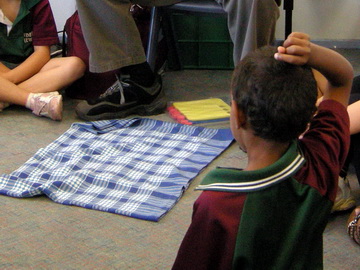
Ten plugs have been removed from the red board, some blue/yellow ones have been put in the spaces and covered.
Can I try to count the secret spaces please. |
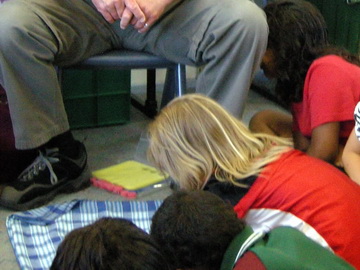
Girls first. Now put your hands under, no peeking, and see if you can count the empty spaces. When you think you know how many it is write it on your calculator. Then it will be a boy's turn. |
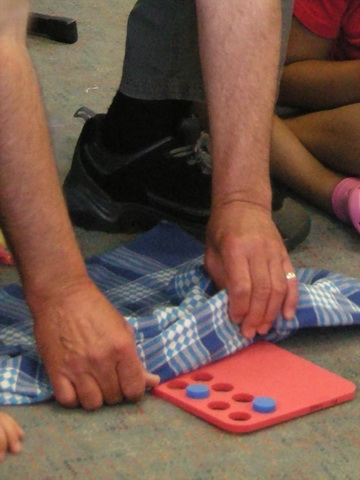
Now, I'll slide the cloth back.
Let's all count the empty spaces as I do it. |
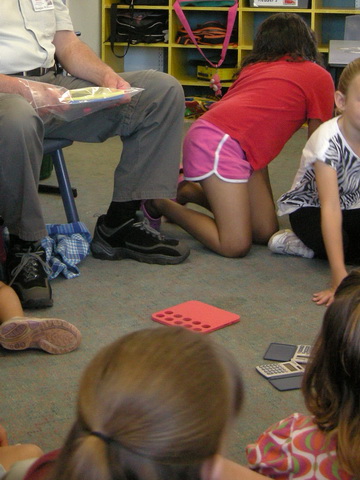
Okay, now we will play again, but everyone has to turn their back before I put any plugs in the board. |

I'm just about to put in some yellow and blue plugs.
No peeking. |
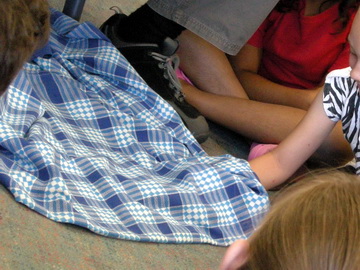
Girls first again. How many empty spaces can you count? You can use two hands if you want to. |

Return to Calculating Changes
Activities
Calculating Changes ... is a division of ... Mathematics Centre
|







